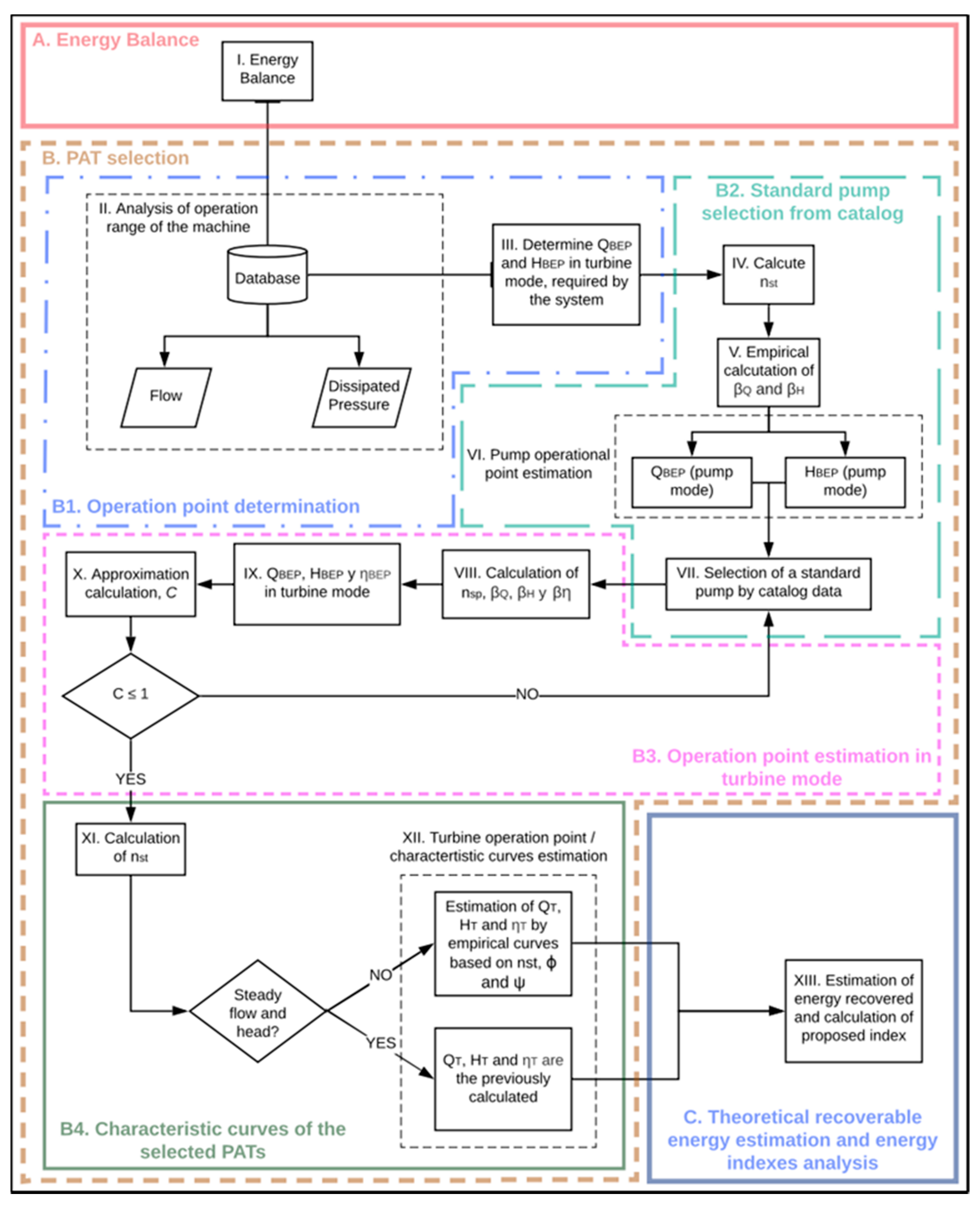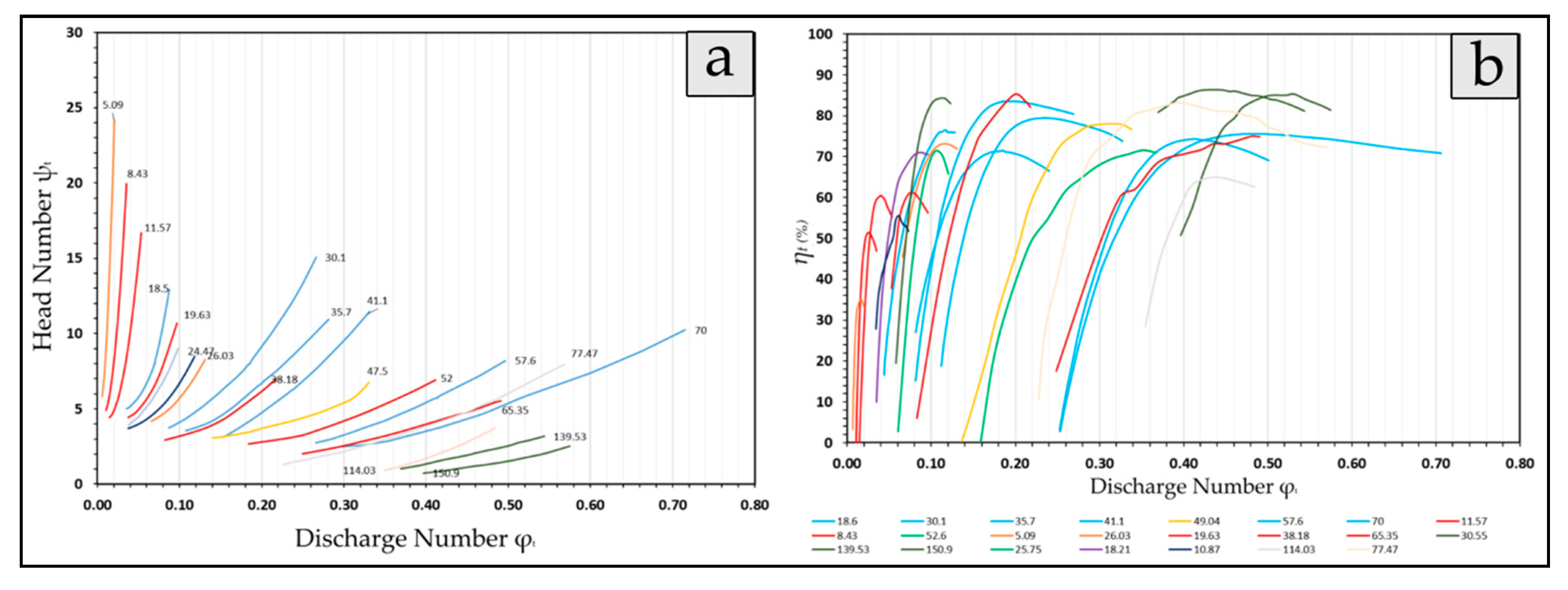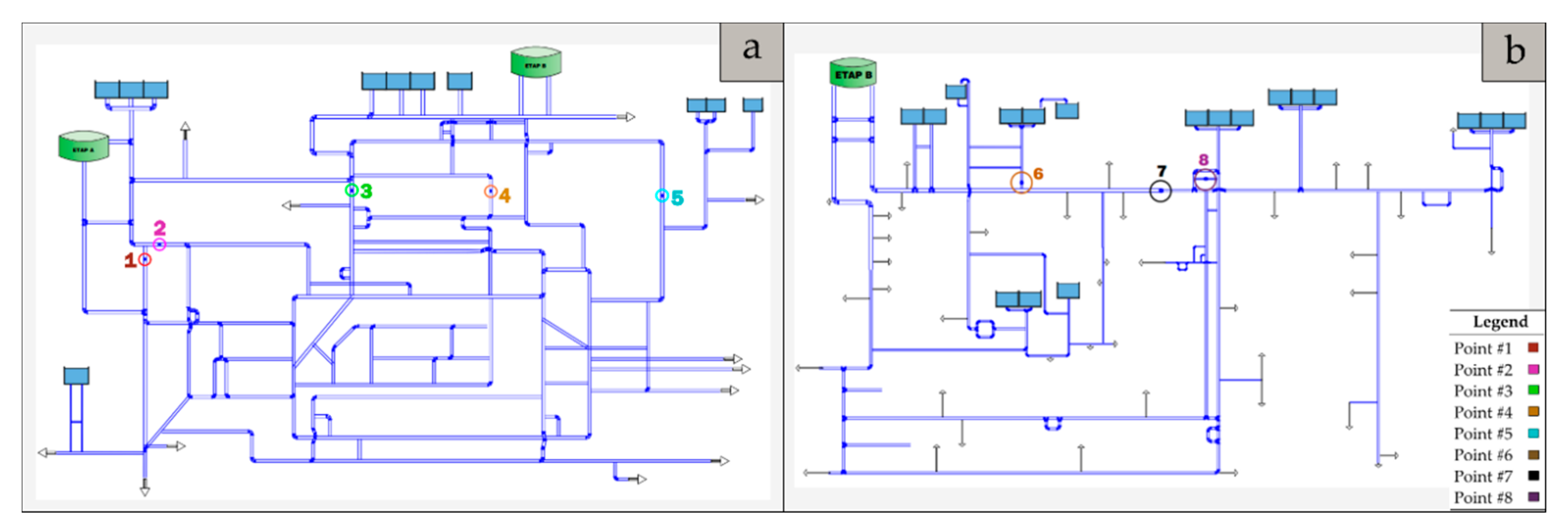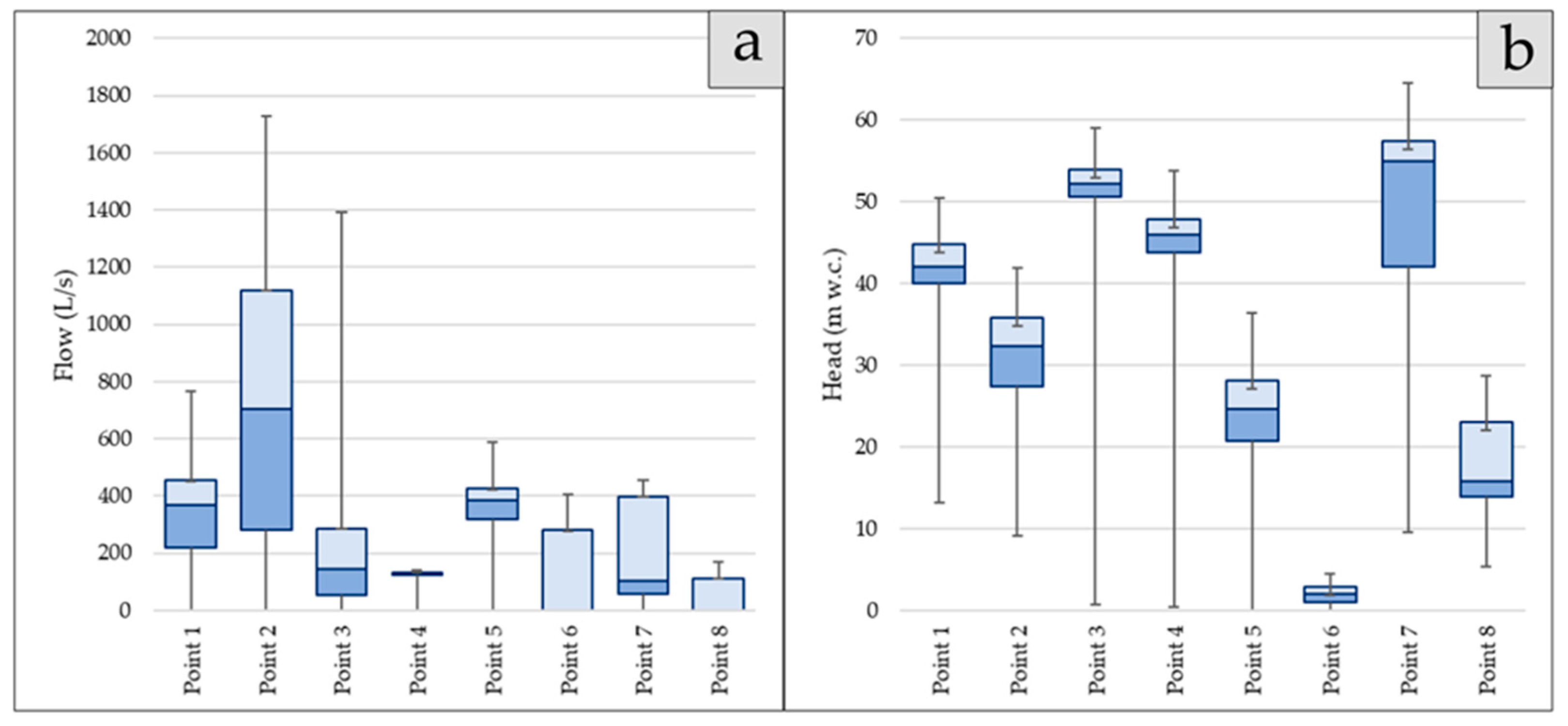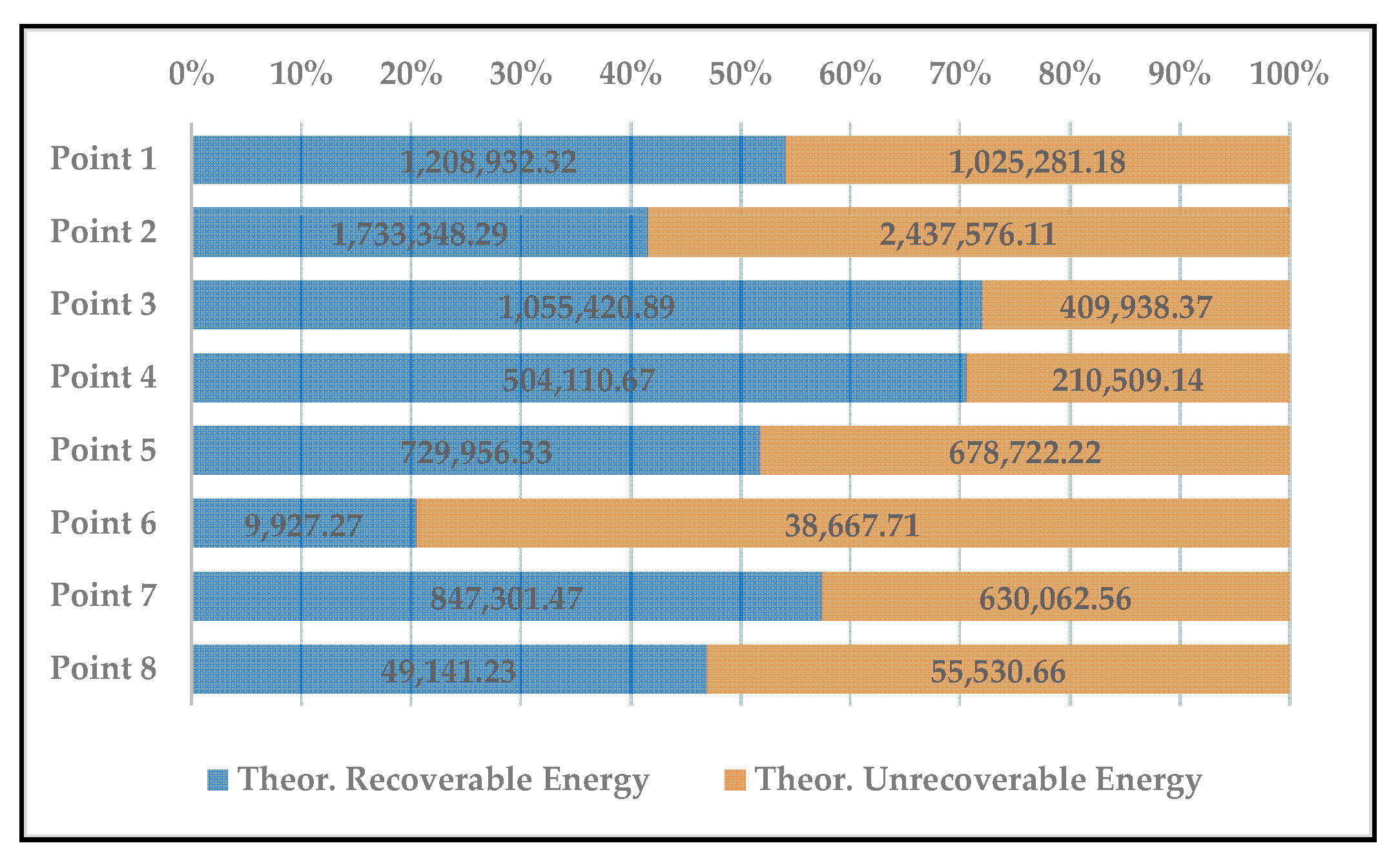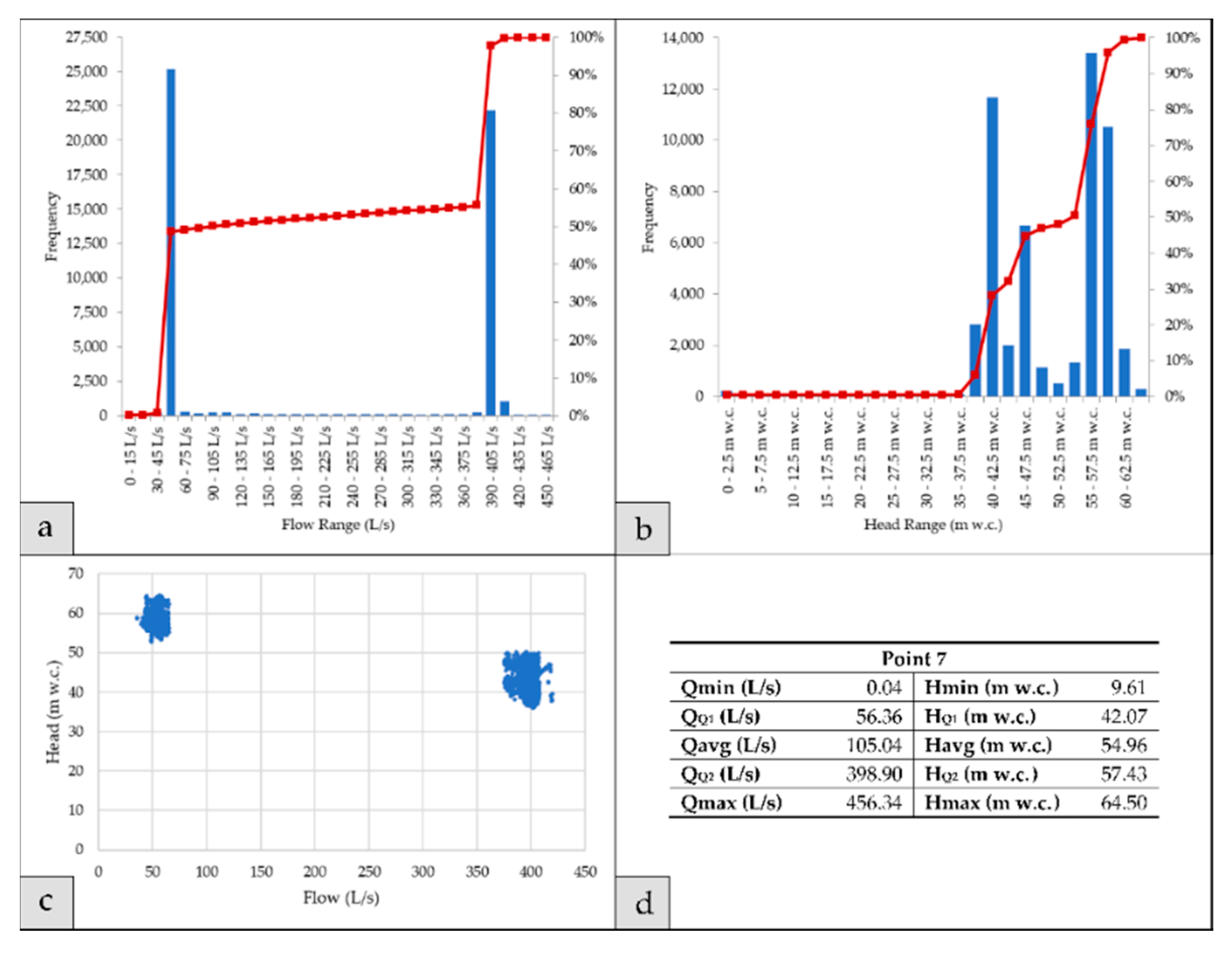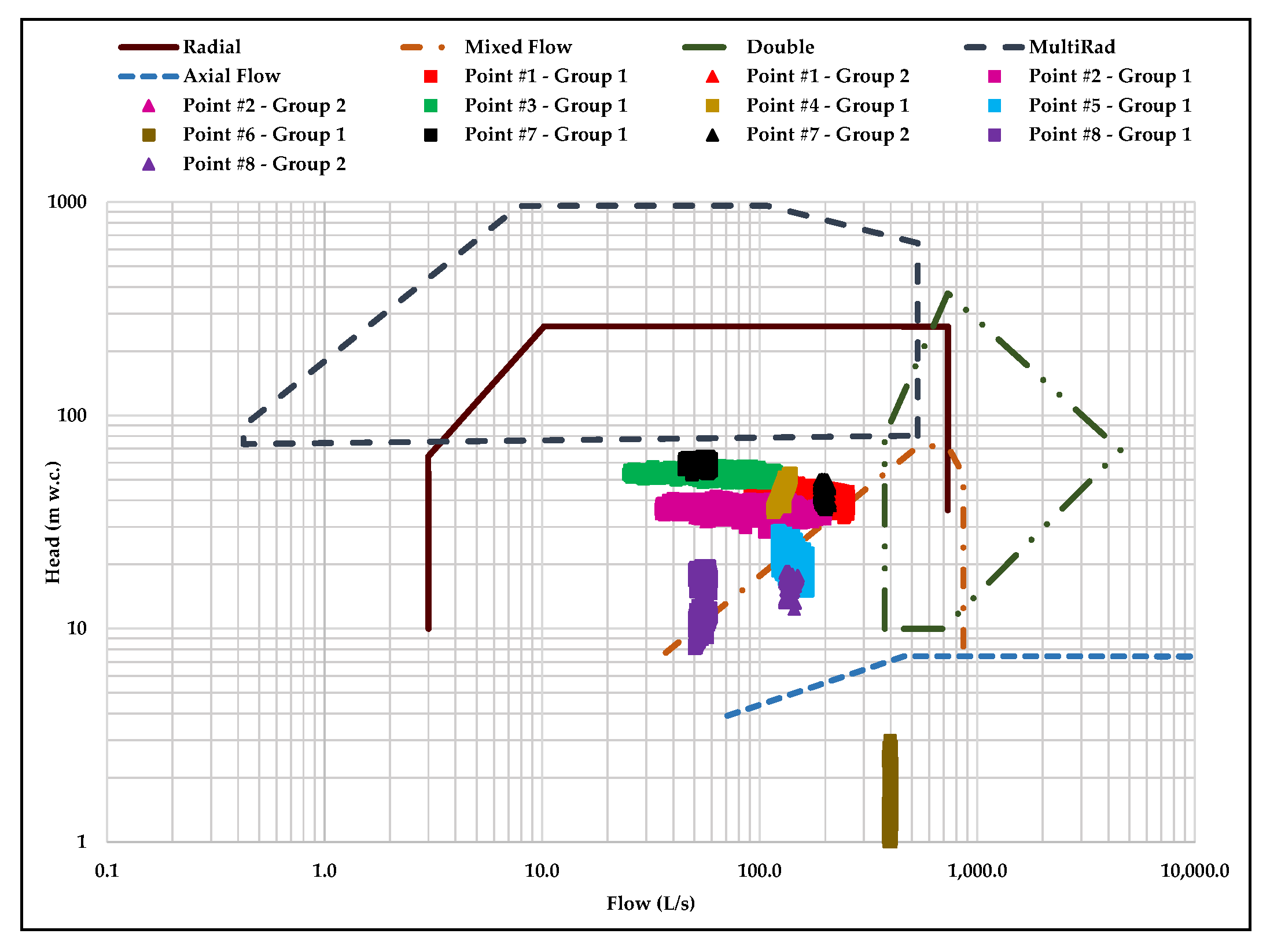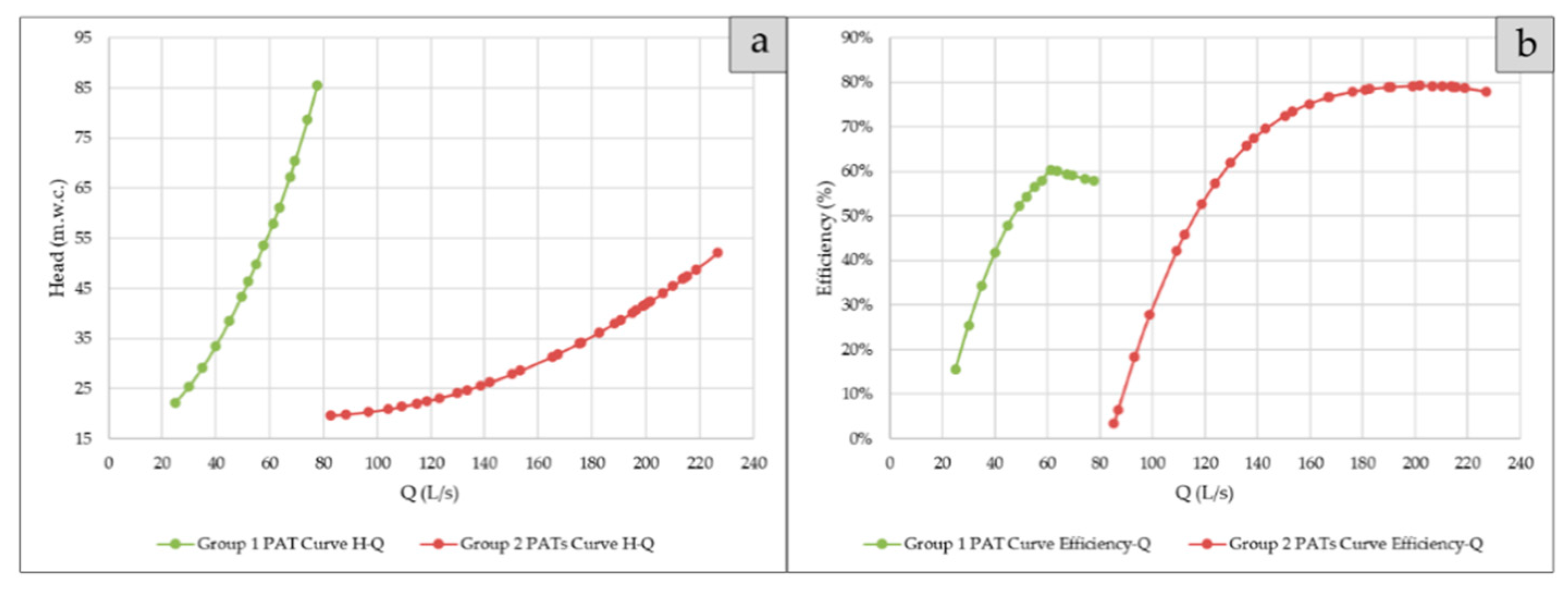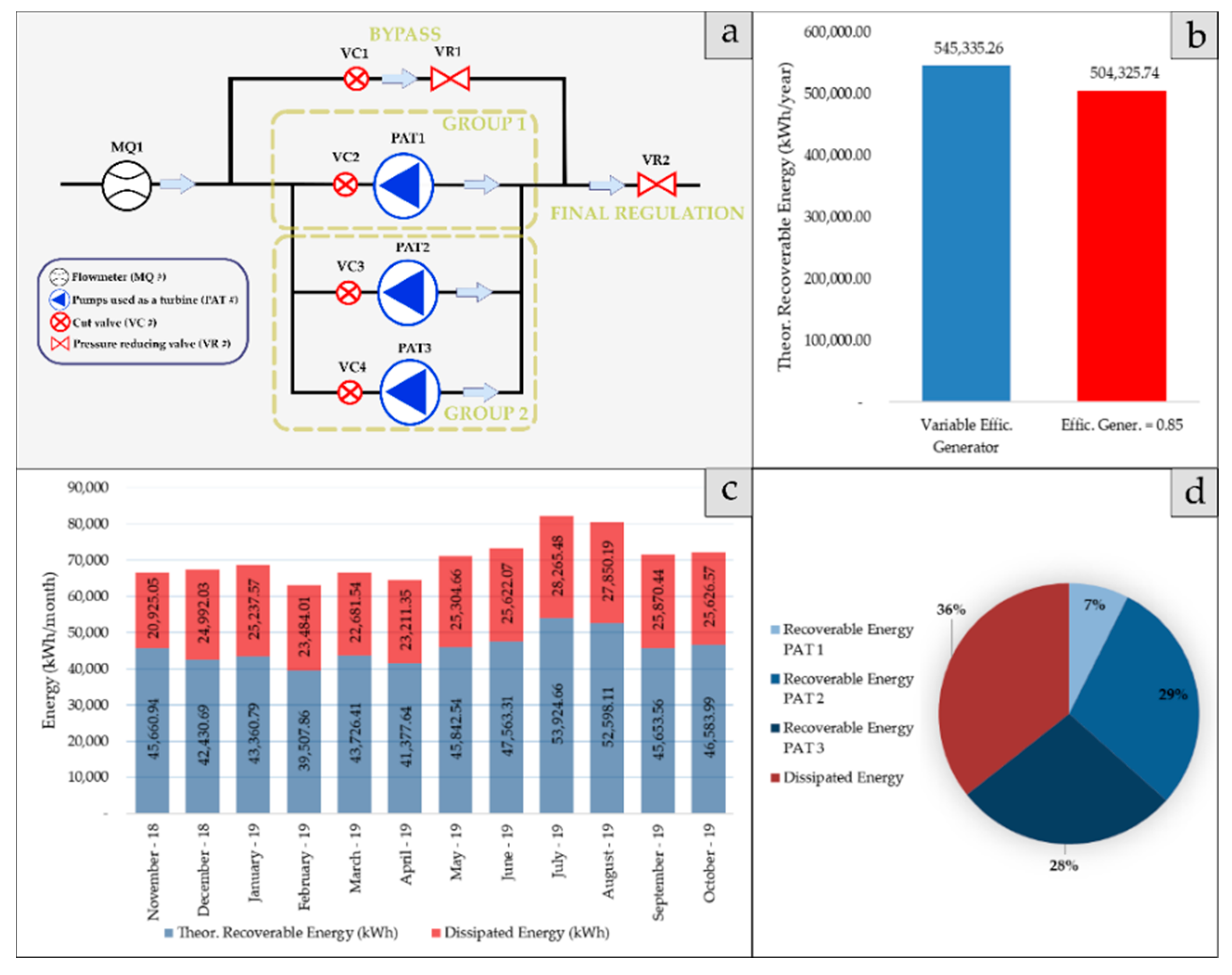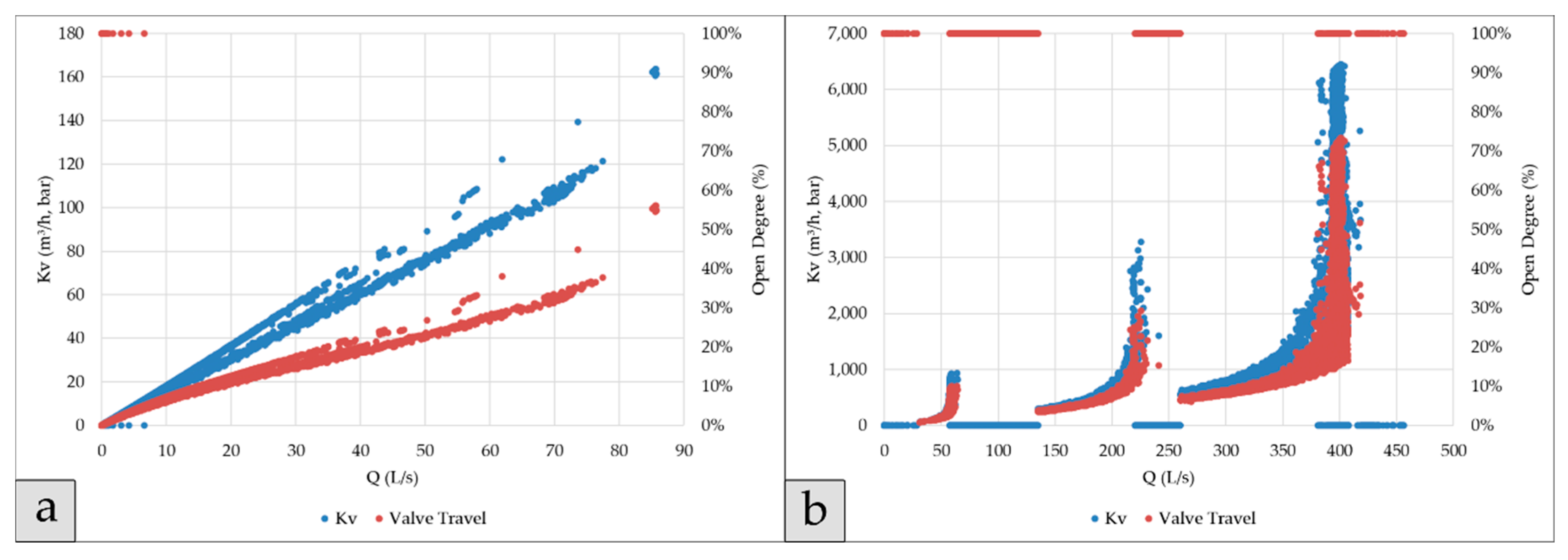Figure 1.
Proposed methodology for the selection of pumps used as turbines (PATs).
Figure 1.
Proposed methodology for the selection of pumps used as turbines (PATs).
Figure 2.
(a) Water distribution system without pressure management. (b) Water distribution system with PATs installed.
Figure 2.
(a) Water distribution system without pressure management. (b) Water distribution system with PATs installed.
Figure 3.
(a) Non-dimensional numbers of discharge and head as a function of the specific speed. (b) Non-dimensional number of discharges as a function of the specific speed.
Figure 3.
(a) Non-dimensional numbers of discharge and head as a function of the specific speed. (b) Non-dimensional number of discharges as a function of the specific speed.
Figure 4.
High-pressure water distribution system scheme from the VMS: (a) Points 1–5. (b) Points 6–8. Note. ETAPB is the connection point between schemes.
Figure 4.
High-pressure water distribution system scheme from the VMS: (a) Points 1–5. (b) Points 6–8. Note. ETAPB is the connection point between schemes.
Figure 5.
(a) Registered flow variability for each study point. (b) Registered dissipated head variability for each study point.
Figure 5.
(a) Registered flow variability for each study point. (b) Registered dissipated head variability for each study point.
Figure 6.
Energy distribution comparison for each point.
Figure 6.
Energy distribution comparison for each point.
Figure 7.
(a) Flow chart, 15 L/s intervals, from point #7. (b) Flow chart, 15 L/s intervals, from point #7. (c) Scatter plot for Q vs. H from point #7. (d) Registered values variability for point #7.
Figure 7.
(a) Flow chart, 15 L/s intervals, from point #7. (b) Flow chart, 15 L/s intervals, from point #7. (c) Scatter plot for Q vs. H from point #7. (d) Registered values variability for point #7.
Figure 8.
Classification for each PAT as a function of the representative operational point for each analyzed case.
Figure 8.
Classification for each PAT as a function of the representative operational point for each analyzed case.
Figure 9.
(a) Curve Q-H for the selected PATs from group 2. (b) Curve Q-efficiency for the selected pumps from group 2.
Figure 9.
(a) Curve Q-H for the selected PATs from group 2. (b) Curve Q-efficiency for the selected pumps from group 2.
Figure 10.
(a) PATs installation scheme for point #7. (b) Theoretical recovery energy for each scenario. (c) Energy recovered by PAT. (d) Energy distribution by month.
Figure 10.
(a) PATs installation scheme for point #7. (b) Theoretical recovery energy for each scenario. (c) Energy recovered by PAT. (d) Energy distribution by month.
Figure 11.
(a) Kv and valve travel for each registered flow for the bypass valve. (b) Kv and open degree for each registered flow for the bypass valve.
Figure 11.
(a) Kv and valve travel for each registered flow for the bypass valve. (b) Kv and open degree for each registered flow for the bypass valve.
Table 1.
Advantages and disadvantages of different pressure management methods.
Table 1.
Advantages and disadvantages of different pressure management methods.
| Method | Advantages | Disadvantages | References |
|---|
| Pressure reducing valves (PRVs) | Cheapest initial investment. Decreases water leaks in the network. Manages the pressure downstream of the valve. Relatively simple design and operation.
| | [4,5] |
| Pressure management zones (PMZs) | | Higher construction investment. Depends on the topography. Need to install PRVs to regulate remaining overpressure.
| [6,7,8] |
| Pumps used as turbines (PATs) | | | [9,10,11,12] |
Table 2.
Data recovered from an analyzed point.
Table 2.
Data recovered from an analyzed point.
| Time (∆t = 10 min) | Q (L/s) | | |
|---|
| 07-11-18 00:00 | 160.98 | 78.23 | 32.95 |
| 07-11-18 00:10 | 160.08 | 78.28 | 32.36 |
| 07-11-18 00:20 | 159.86 | 78.28 | 32.42 |
| 07-11-18 00:30 | 137.14 | 78.38 | 32.18 |
| 07-11-18 00:40 | 115.04 | 78.50 | 32.27 |
| 07-11-18 00:50 | 104.94 | 78.44 | 31.63 |
| 07-11-18 01:00 | 95.40 | 78.73 | 32.25 |
| 07-11-18 01:10 | 81.64 | 78.72 | 31.60 |
| 07-11-18 01:20 | 72.95 | 79.02 | 32.25 |
| 07-11-18 01:30 | 67.22 | 79.05 | 32.10 |
| 07-11-18 01:40 | 63.66 | 79.07 | 31.69 |
| 07-11-18 01:50 | 74.86 | 78.96 | 31.89 |
| 07-11-18 02:00 | 76.96 | 78.82 | 31.57 |
| 07-11-18 02:10 | 76.97 | 78.85 | 31.51 |
| Minimum Value | 0.29 | 26.33 | 28.66 |
| Maximum Value | 768.36 | 79.67 | 75.37 |
| Mean Value | 342.90 | 76.23 | 33.90 |
| Standard Deviation | 147.04 | 1.90 | 1.78 |
Table 3.
Calculation expression for the different types of energy in a water distribution system.
Table 3.
Calculation expression for the different types of energy in a water distribution system.
| Energy | Calculation Expression | |
|---|
| Total energy (ET) | | (1) |
| Friction energy (EFR) | | (2) |
| Theoretical energy necessary (ETN) | | (3) |
| Energy required for consumption (ERI) | | (4) |
| Theoretical available energy (ETA) | | (5) |
| Theoretical recoverable energy (ETR) | | (6) |
| Theoretical unrecoverable energy (ENTR) | | (7) |
Table 4.
Empirical relationship to define the best efficiency point of a machine as a function of the specific speed proposed by [
20]. In
Table 4, the variable
is the best efficiency obtained from the machine working as a pump.
Table 4.
Empirical relationship to define the best efficiency point of a machine as a function of the specific speed proposed by [
20]. In
Table 4, the variable
is the best efficiency obtained from the machine working as a pump.
| Coefficient | Empiric Expression |
|---|
| |
| |
| |
| |
| |
| |
| |
Table 5.
Proposed empirical equations to predict conversion coefficients.
Table 5.
Proposed empirical equations to predict conversion coefficients.
| Author | | | |
|---|
Stephanoff
[22] | | | 1 |
Mc. Claskey
[23] | | | 1 |
Alatorre-Frenk
[24] | | | |
Sharma-Williams
[25] | | | 1 |
Yang et al.
[26] | | | |
Hancock
[27] | | | |
Barbarelli
[28] | | | |
Grover
[29] | | | |
Hergt
[30] | | | |
Table 6.
Proposed sustainability indicators.
Table 6.
Proposed sustainability indicators.
| Abbreviation | Units | Indicator | Calculation |
|---|
| IED | Dimensionless | Energy dissipation | |
| IAE | kWh/year | Annual consumed energy | Sum of the total active energy consumed in the network |
| IEFW | kWh/m3 | Consumed energy per unit volume | Ratio between the active energy consumed and the total volume of water introduced in the system |
| IEC | €/m3 | Energy cost per unit volume introduced | Ratio between energy cost and the total volume of water introduced in the system |
| IER | kWh/year | Energy recovered | Sum of total energy recovered in the network |
| ERP | % | Recoverable energy percentage | Recoverable energy percentage used of the total energy consumed in the system |
| IAAE | kWh/year | Absolute annual consumed energy | Sum of the total active energy consumed in the network subtracted by the sum of the total energy recovered in the network |
| IAEFW | kWh/m3 | Absolute consumed energy per unit volume | Ratio between IAAE and the total volume of water introduced in the network |
Table 7.
Annual energy distribution from point #7.
Table 7.
Annual energy distribution from point #7.
| Annual Energy Distribution |
|---|
| Total Energy (kWh) | 1,477,364.03 | Percentage (%) |
|---|
| Theoretical Recoverable Energy (kWh) | 847,301.47 | 57.35% |
| Theoretical Unrecoverable Energy (kWh) | 630,062.56 | 42.65% |
Table 8.
Highlights from energy balance at point #7 for each scenario.
Table 8.
Highlights from energy balance at point #7 for each scenario.
| Energy Production with PATs Installed |
|---|
| Category | η = 100% | η = 60% | Units |
|---|
| Max Theoretical Rec. Power | 199.57 | 119.74 | kW |
| Avg. Theoretical Rec. Power | 28.03 | 57.87 | kW |
| Theoretical Rec. Energy (Annual) | 847,301.47 | 508,380.88 | kwh/year |
| Avg. Theoretical Rec. Energy (Monthly) | 70,608.46 | 42,365.07 | kwh/month |
| Min Theoretical Rec. Energy (Monthly) | 62,991.87 | 37,795.12 | kwh/February |
| Max Theoretical Rec. Energy (Monthly) | 82,190.15 | 49,314.09 | kwh/July |
| Avg. Theoretical Rec. Energy (Daily) | 2315.03 | 1389.02 | kwh/day |
| Avg. Theoretical Rec. Energy (Hourly) | 96.46 | 57.88 | kwh/h |
Table 9.
Operational point for each PAT at every study case.
Table 9.
Operational point for each PAT at every study case.
| Operational for each Analyzed Point | Assumed n (rpm) | 1450 |
|---|
| Analyzed Point | PAT Group | PATs in Group | Flow (L/s) | Head (m w.c.) | nST (m, kW) |
|---|
| Point #1 | 1 | 2 (Parallel) | 210.00 | 40.50 | 41.39 |
| 2 | 1 | 117.50 | 46.50 | 27.91 |
| Point #2 | 1 (Parallel) | 1 | 125.00 | 36.50 | 34.52 |
| 1 | 175.00 | 36.50 | 40.85 |
| Point #3 | 1 (Parallel) | 3 | 80.00 | 51.75 | 21.26 |
| Point #4 | 1 | 1 | 132.50 | 47.50 | 29.17 |
| Point #5 | 1 (Parallel) | 3 | 141.67 | 24.00 | 50.33 |
| Point #6 | Not enough data to select a pump |
| Point #7 | 1 | 1 | 57.00 | 56.00 | 16.91 |
| 2 | 2 (Parallel) | 200.00 | 41.50 | 39.66 |
| Point #8 | 1 | 2 (Parallel) | 57.00 | 10.50 | 59.35 |
| 2 | 1 | 143.50 | 16.00 | 68.66 |
Table 10.
Initial data for conversion from point #7.
Table 10.
Initial data for conversion from point #7.
| Initial Data—Point #7 |
|---|
| Category | Group 1 | Group 2 | Units |
|---|
| QBEPt | 57.00 | 200.00 | L/s |
| HBEPt | 56.00 | 41.50 | m w.c. |
| nt | 1450.00 | 1450.00 | rpm |
| nst | 16.91 | 39.66 | m, kW |
Table 11.
Data conversion from turbine mode to pump mode (point #7).
Table 11.
Data conversion from turbine mode to pump mode (point #7).
| Data Conversion from Turbine Mode to Pump Mode |
|---|
| Authors | Group 1 | Group 2 |
|---|
| βQ | βH | QBEP, p (L/s) | HBEP, p (m w.c.) | βQ | βH | QBEP, p (L/s) | HBEP, p (m w.c.) |
|---|
| Pérez-Sánchez et al. | 1.68 | 1.90 | 33.94 | 29.51 | 1.29 | 1.46 | 154.98 | 28.46 |
| Grover | 1.93 | 2.31 | 29.49 | 24.29 | 1.33 | 1.78 | 150.15 | 23.25 |
| Hergt | 1.17 | 0.87 | 48.90 | 64.47 | 1.25 | 1.14 | 159.51 | 36.52 |
Table 12.
Selected pumps and best efficiency point data for each group (point #7).
Table 12.
Selected pumps and best efficiency point data for each group (point #7).
| Selected Pump for Each Group |
|---|
| Group 1 | Group 2 |
|---|
| Model | CPH 100-375 | Model | NK 150-315 |
| QBEP P | 37.42 | L/s | QBEP P | 146.85 | L/s |
| HBEP P | 30.00 | m w.c. | HBEP P | 27.40 | m w.c. |
| ηBEP P | 0.69 | - | ηBEP P | 0.82 | - |
| nP | 1450 | rpm | nP | 1,450 | rpm |
| nsp | 21.88 | m, kW | nsp | 46.40 | m, kW |
Table 13.
Conversion coefficients from pump mode to turbine mode for each group of point #7.
Table 13.
Conversion coefficients from pump mode to turbine mode for each group of point #7.
| | Conversion Coefficient (from Pump Mode to Turbine Mode) |
|---|
| | Group 1 | Group 2 |
|---|
| | Model | CPH 100–375 | Model | NK 150–315 |
| Authors | βQ | βH | βη | βQ | βH | βη |
| Pérez-Sánchez | 1.46 | 1.79 | 0.88 | 1.34 | 1.51 | 0.98 |
| Stephanoff | 1.2 | 1.45 | 1 | 1.1 | 1.22 | 1 |
| Mc. Claskey | 1.45 | 1.45 | 1 | 1.22 | 1.22 | 1 |
| Alatorre-Frenk | 1.96 | 1.93 | 0.96 | 1.38 | 1.43 | 0.96 |
| Hancock | 1.45 | 1.45 | N/A | 1.22 | 1.22 | N/A |
| Barbelli | 1.55 | 1.87 | N/A | 1.36 | 1.43 | N/A |
| Yang et al. | 1.47 | 1.8 | N/A | 1.34 | 1.49 | N/A |
| Sharma-Williams | 1.35 | 1.56 | 1 | 1.17 | 1.27 | 1 |
Table 14.
Pump mode operation point estimation for each group of point #7.
Table 14.
Pump mode operation point estimation for each group of point #7.
| | Pump Mode Operational Point Estimation |
|---|
| | Group 1 | Group 2 |
|---|
| | Model | CPH 100-375 | Model | NK 150-315 |
| Authors | QBEP T (L/s) | HBEP T (m w.c.) | ηBEP T | nST | C | QBEP T (L/s) | HBEP T (m w.c.) | ηBEP T | nST | C |
| Pérez-Sánchez | 54.55 | 53.64 | 0.61 | 17.09 | 0.14 | 196.48 | 41.27 | 0.8 | 39.47 | 0.07 |
| Stephanoff | 45.05 | 43.48 | 0.69 | 18.18 | 0.73 | 162.27 | 33.46 | 0.82 | 41.99 | 0.64 |
| Mc. Claskey | 54.23 | 43.48 | 0.69 | 19.94 | 0.99 | 179.3 | 33.46 | 0.82 | 44.14 | 0.67 |
| Alatorre-Frenk | 73.44 | 57.92 | 0.66 | 18.72 | 1.38 | 203.01 | 39.24 | 0.79 | 41.67 | 0.35 |
| Hancock | 54.23 | 43.48 | N/A | 19.94 | 0.99 | 179.3 | 33.46 | N/A | 44.14 | 0.67 |
| Barbelli | 57.96 | 55.98 | N/A | 17.06 | 0.09 | 199 | 39.18 | N/A | 41.31 | 0.27 |
| Yang et al. | 55.07 | 54.15 | N/A | 17.05 | 0.11 | 196.67 | 40.96 | N/A | 39.72 | 0.05 |
| Sharma-Williams | 50.35 | 46.83 | 0.69 | 18.18 | 0.52 | 172.28 | 34.82 | 0.82 | 41.99 | 0.51 |
Table 15.
Best efficiency point (BEP) (pump and turbine mode) for the selected pumps from each point.
Table 15.
Best efficiency point (BEP) (pump and turbine mode) for the selected pumps from each point.
| Analyzed Point | PAT Group | Pump Selected | Best Efficiency Point for Selected Pumps | Best Efficiency Point (Turbine Mode) |
|---|
| Q (L/s) | H (m w.c.) | ηP | nSP (m, kW) | Flow (L/s) | Head (m w.c.) | ηT | nST (m, kW) | C |
|---|
| Point #1 | 1 | TP 200-320/4 | 154.6 | 27.8 | 0.84 | 47.2 | 204.4 | 40.8 | 0.83 | 40.6 | 0.17 |
| 2 | GNI 150-40/75 | 90.0 | 34.3 | 0.83 | 30.7 | 119.6 | 51.0 | 0.77 | 26.3 | 0.44 |
| Point #2 | 1 | GNI 150-32/40 | 85.5 | 24.0 | 0.81 | 39.1 | 115.0 | 36.6 | 0.78 | 33.1 | 0.43 |
| RNI 200-32 | 127.5 | 22.5 | 0.8 | 50.1 | 173.1 | 34.9 | 0.79 | 42.0 | 0.19 |
| Point #3 | 1 | GNI 125-32/40 | 56.2 | 31.9 | 0.78 | 25.6 | 77.1 | 50.5 | 0.7 | 21.3 | 0.12 |
| Point #4 | 1 | GNI 150-32/60 | 102.1 | 33.1 | 0.85 | 33.6 | 134.1 | 48.0 | 0.8 | 29.1 | 0.04 |
| Point #5 | 1 | CPH 150-290 | 103.0 | 15.47 | 0.83 | 59.7 | 137.3 | 23.1 | 0.84 | 50.9 | 0.11 |
| Point #6 | Not enough data to select a pump |
| Point #7 | 1 | CPH 100-375 | 37.4 | 30.0 | 0.69 | 21.9 | 54.6 | 53.6 | 0.61 | 17.1 | 0.14 |
| 2 | NK 150-315 | 146.9 | 27.4 | 0.82 | 46.4 | 196.5 | 41.3 | 0.8 | 39.5 | 0.07 |
| Point #8 | 1 | NB/NK 125-200/196-172 | 53.0 | 7.6 | 0.77 | 73.2 | 73.3 | 12.2 | 0.8 | 60.3 | 0.98 |
| 2 | NB/NK 150-250 | 104.2 | 10.9 | 0.74 | 78.3 | 146.3 | 18.0 | 0.78 | 63.4 | 0.58 |
Table 16.
Defining variables for the empirical curves from the selected PATs.
Table 16.
Defining variables for the empirical curves from the selected PATs.
| Selected PATs for Each Group |
|---|
| Group 1 | Group 2 |
|---|
| Model | CPH 100-375 | Model | NK 150-315 |
|---|
| QBEP T | 54.55 | L/s | QBEP T | 196.48 | L/s |
| HBEP T | 53.64 | m w.c. | HBEP T | 41.27 | m w.c. |
| ηBEP T | 0.61 | | ηBEP T | 0.80 | |
| nT | 1450.00 | rpm | nT | 1450.00 | rpm |
| nST | 17.09 | m, kW | nST | 39.47 | m, kW |
| D | 325.00 | mm | D | 310.00 | mm |
| φ | 0.07 | (m3/s, rps) | φ | 0.27 | (m3/s, rps) |
| ψ | 8.53 | (m/s², rps²) | ψ | 7.21 | (m/s², rps²) |
Table 17.
Selected valves for the system.
Table 17.
Selected valves for the system.
| | By-Pass | Final Regulation |
|---|
| Model | 700-ES | 700/700-EN |
| Connection Type | Y-Pattern | G-Pattern |
| Disc Type | Flat Disc | Flat Disc |
| DN (mm) | 125 | 600 |
| (m3/h, 1 bar) | 215 | 7300 |
Table 18.
Sustainability indicators for point #7 [
3].
Table 18.
Sustainability indicators for point #7 [
3].
| | Before | After | Change |
|---|
| IED | 0.58 | 0.21 | −64.16% |
| IAE (kWh/year) | 1,477,364.03 | 1,477,364.03 | |
| IEFW (kWh/m3) | 4.06 | 4.06 | |
| IEC (€/m3) | 0.036 | 0.023 | −35.01% |
| IAAE (kWh/year) | 1,477,364.03 | 932,028.77 | −36.91% |
| IAEFW (kWh/m3) | 4.06 | 2.56 | −36.91% |
| IER (kWh/year) | | 545,335.26 | +545,335.26 |
| ERP (%) | | 36.91% | +36.91% |
